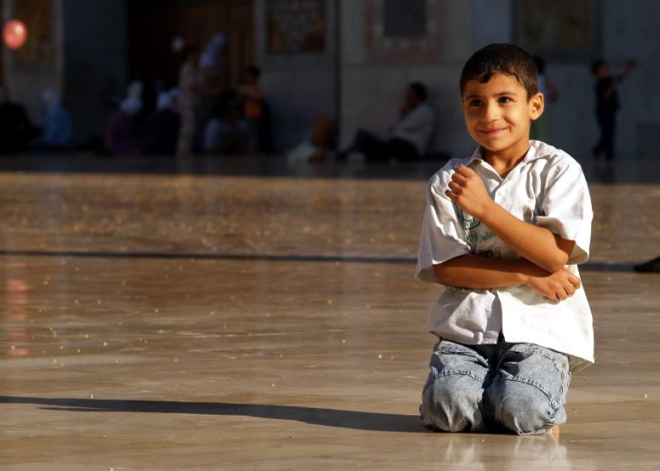
Photo by James Gordon, Los Angeles, California, USA: “Playful boy in the expansive courtyard of the Great Umayyad Mosque of Damascus, Syria” Public domain, via Wikimedia Commons. This mosque, the fourth holiest place in Islam, is now in ruins.
It’s time to revisit two themes: “What do we tell the children?” and “What do we teach the children?” In other words, v’ahavta l’reacha kamocha, “Love your neighbor (or stranger) as yourself.”

On Saturday, January 27, Trump issued his now-famous executive order banning residents of seven designated predominantly Muslim nations from entering the United States. Noteworthy is the fact that the order contains the phrase “foreign terrorist” but not “refugees.” Among these foreign terrorists detained was a four-month-old infant in need of open-heart surgery, and a one-year-old with cancer. In fact, world wide, children, already among the most vulnerable, are suffering in disproportionate numbers.
What do we mean by “extreme vetting”? A Homeland Security official explains that refugees have been been vetted thoroughly all along.
Teaching and Supporting the Children
Teaching Tolerance, a project of the Southern Poverty Law Center, offers a comprehensive guide for educators and school support staff in dealing with the many complex issues of immigrants and refugees. Says the report,
“Schools should be safe havens that embrace all students and families, regardless of citizenship and national origin, and that includes unaccompanied and refugee children. The 1982 U.S. Supreme Court case Plyler v. Doe ruled that undocumented children have a constitutional right to receive a free public K–12 education, which provides the means to becoming a “self-reliant and self-sufficient participant in society,” the court wrote, and instills the “fundamental values necessary to the maintenance of a democratic political system.” However, today’s increased enforcement measures by the Department of Homeland Security and campaign promises made by the incoming administration threaten that right for thousands of undocumented youth and the 4.1 million U.S.-born children who live in mixed-status households with at least one parent or family member who is undocumented.”
The report offers facts about undocumented students, immigration raids, what school communities can do, and taking action beyond the classroom.
A companion piece, “What Do I Say to Students about Immigration Orders?” offers clear, honest tips for helping undocumented students and children of undocumented parents. This thoughtful essay offers ten additional steps of constructive action teachers and other adult role models can take.
Out Beyond the School
On Wednesday, February 1, Trump cut a call with Australian Prime Minister Malcolm Turnbull short, refusing to honor America’s earlier pledge to take in 1,200 refugees. These are the refugees who had been relocated to the Papua New Guinea island of Nauru. The refugees consist mainly of families, many children among them. Witnesses – both the children themselves and the human rights group Amnesty International – describe the conditions there as inhumane.
Meanwhile, Samantha Bee had to put aside her humor in her scathing segment that night. Then, again, so was Trevor Noah, using the same c-bomb.
Forces of Good(ness) in the Twitterverse
Bana Alabed, thankfully safe, had a poignant question for the president, seeking his empathy. Bana is the brave little Syrian girl who has been using Twitter to alert the world of the plight of these children, now political pawns subject to the political whims of egomaniac adults.

The video can be found here. Please follow her! Bana’s mother, Fatemah, has also set up a Twitter account. Mother and daughter preach love, peace, and understanding. These are the message we need so much more of.
After the Super Bowl
Here’s the full, uncut version of the famous advertisement by 84 Lumber. It’s beautiful!
